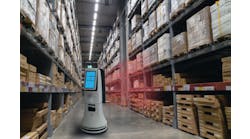In our interconnected globalized world, the demand for seamless logistics has given rise to the emergence of smart warehouses powered by automation and artificial intelligence.
These state-of-the-art facilities are now hubs of interconnected technologies, all orchestrated by intelligent software that manages most aspects of the business operation. Within these “smart” warehouses, tasks like order processing, item identification, sorting, packaging, and preparation for shipment are executed automatically and with precision.
See also: Navigating Industry 4.0: A guide for the rest of us
By the end of this decade, the goal is to transform warehouses into fully self-managed entities, with humans assuming the role of robot supervisors. This shift will enable people to focus on business aspects requiring creativity and unique human skills, while simultaneously relieving them of laborious and physically demanding manual tasks.
So, which warehouse processes will experience the most seismic impact?
Automated storage and retrieval
The storage and retrieval of goods is the most automated process in warehouses today, often performed by automated storage and retrieval systems (ASRS). ASRS are typically computer-controlled inventory management solutions that streamline the handling, storing, and retrieval of items within a warehouse.
See also: How advanced metering infrastructure is powering smarter operations
These systems usually fall into three categories: shelf-based, bin-based, or robot-based. Their levels of complexity differ, with the selection based on the specific requirements and operational dynamics of the warehouse in question.
A significant benefit of modern ASRS is their ability to effectively utilize floor and height space within a warehouse. AutoStore, for example, is operated by autonomous robots that move on top of an aluminum cubic grid that can boost storage capacity by up to four times within the same footprint.
Plus, when the ASRS is seamlessly integrated with an AI-powered warehouse control system, various factors like product attributes, picking frequency, and real-time order priorities are considered to optimize order picking routes. This enables warehouse operators to intelligently sequence orders and optimize travel paths leading to improved order accuracy and throughput as well as reduced labor costs.
Another approach to warehouse optimization involves the use of floor robots, such as autonomous mobile robots (AMRs). Although they are not classified as ASRS, these robots can complement ASRS systems. AMRs operate autonomously and can navigate in an uncontrolled environment without the need for predetermined paths or tracks.
Order picking and handling
After implementing automation for goods storage and retrieval, the next logical step towards a fully self-managed warehouse is upgrading the pick-and-place technology to achieve maximum autonomy.
The future of logistics lies in advanced robotic arms such as eOperator. Typically equipped with a camera and gripping hands that offer suction capabilities and movable fingers, these robotic arms utilize sophisticated machine learning algorithms to instantly determine the most efficient method for picking an item.
See also: Reducing remote site downtime through better network monitoring
They can pick and place thousands of products rapidly, reducing human error and ensuring accurate order fulfillment for customers. Featuring an intuitive user interface, operational dashboard, and service portal, these robotic arms seamlessly integrate with ASRS systems.
The robotic arm doesn’t replace human employees but enhances them. By minimizing human touchpoints, it streamlines the flow from warehouse to customer, resulting in improved operational efficiency. This approach empowers employees to work smarter, take on increased responsibilities, and enjoy a more ergonomic work environment.
Advanced data-driven software
Handling extensive volumes of data can be an overwhelming task, encompassing everything from data collection and processing to in-depth analytics. That’s why it’s essential for warehouse operators to invest in a software solution tailor-made to solve their specific challenges.
There are a multitude of use cases for data-driven software. This software can automatically guide warehouse workers on their daily tasks and even incorporate task gamification to boost employee morale. It can also provide early alerts for proactive maintenance of automated equipment, thereby ensuring higher uptime.
See also: Optimizing production through HMI and controller integration
For business leaders, it enables intelligent decision-making around the handling of goods within and beyond the warehouse. Artificial intelligence goes beyond traditional data analytics, surpassing manual methods by uncovering patterns and trends that might otherwise go unnoticed.
Looking ahead to 2030
While AI’s current usage is in its early stages, its potential for pioneering new applications has no boundaries. Imagine a future where orders can be located, picked, moved through the warehouse, and then dispatched, all with a single press of a button.
This vision is rapidly gaining momentum—and we could see it become a reality by 2030.



